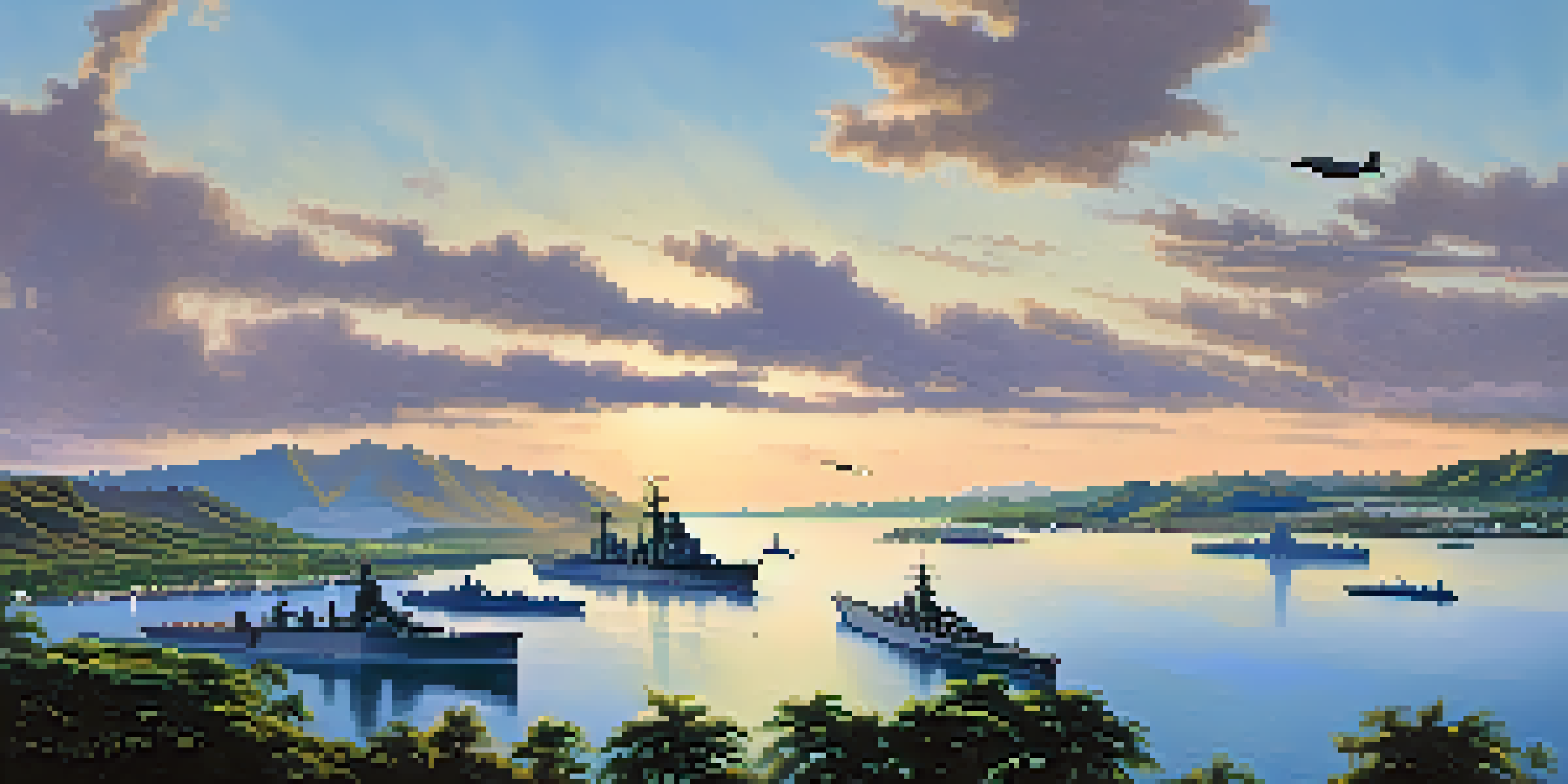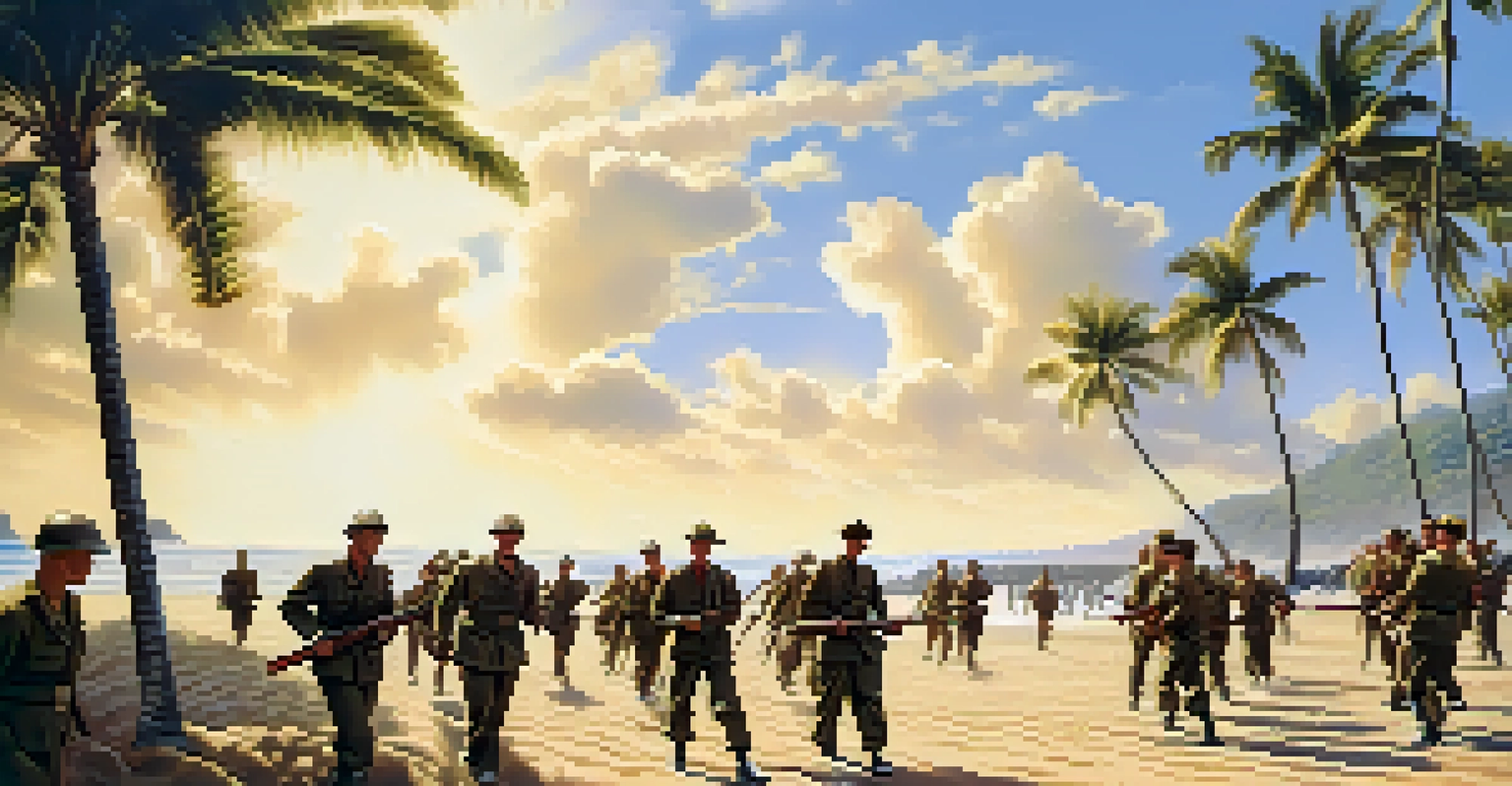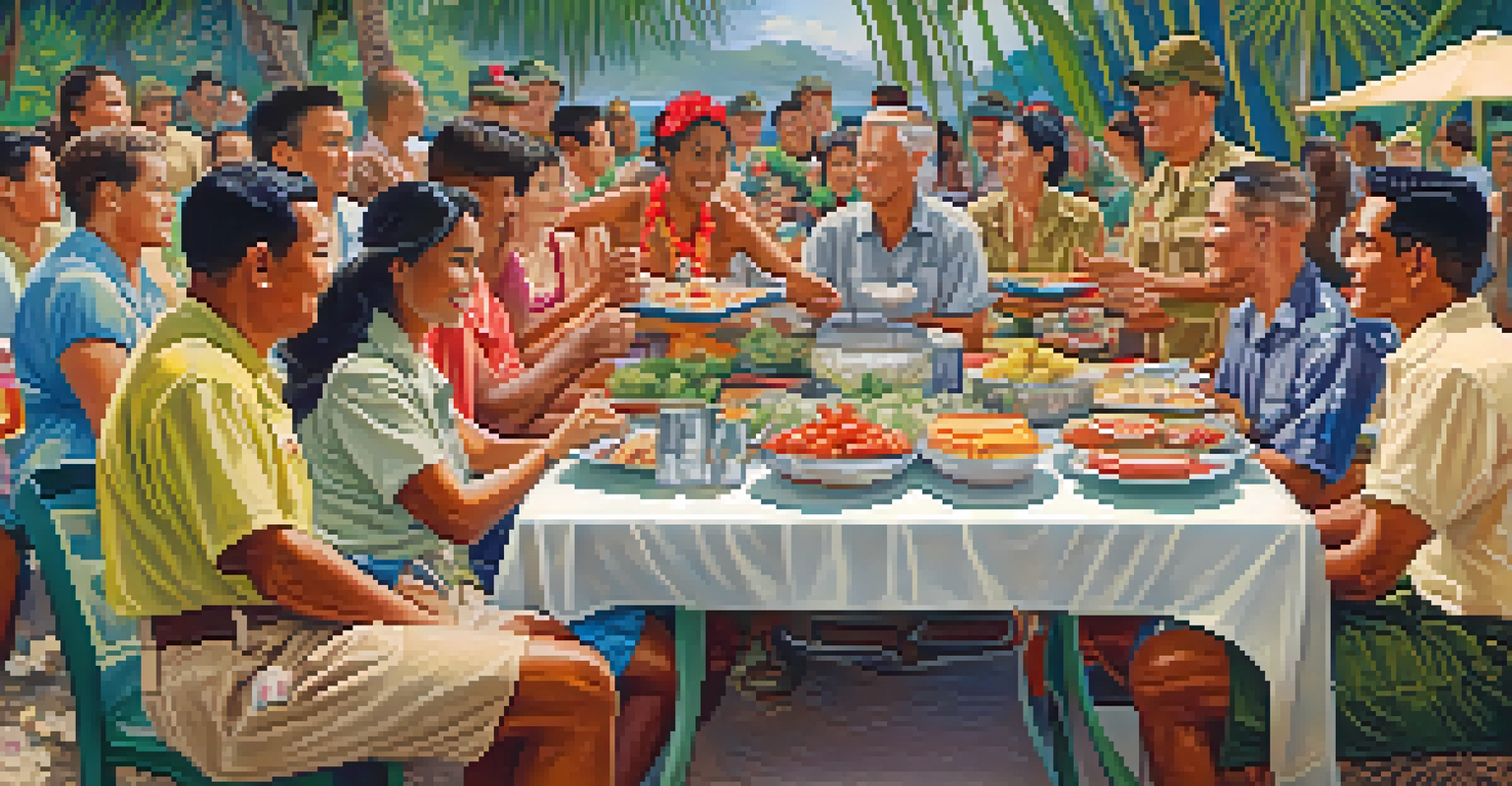World War II and Hawaii: Strategic Importance and Changes

The Geopolitical Significance of Hawaii in WWII
Hawaii's location in the central Pacific made it a crucial point for military strategy during World War II. Positioned between the U.S. mainland and Asia, it served as a vital link for supply routes and troop movements. The islands acted as a forward base for American forces, allowing for quicker responses to threats in the Pacific theater. This strategic importance was highlighted by the attack on Pearl Harbor, which underscored Hawaii's role in global military operations.
In the midst of chaos, there is opportunity.
With the onset of the war, Hawaii became a hub for the U.S. Navy and Army, facilitating the launch of numerous operations against Japanese forces. The establishment of bases like Pearl Harbor and Hickam Field transformed the islands into a bustling military outpost. In this context, Hawaii not only provided a staging ground for operations but also played a critical role in the defense of the West Coast. The focus on these islands marked a significant shift in military strategy that would have lasting implications.
Furthermore, the strategic importance of Hawaii extended beyond military operations; it influenced diplomatic relations and intelligence efforts in the region. The islands served as a base for gathering intelligence on Japanese movements and activities. This role would ultimately shape the course of the war in the Pacific, reinforcing Hawaii's position as a key player in not just military strategy but also in international relations.
Pearl Harbor: Catalyst for U.S. Involvement in WWII
The attack on Pearl Harbor on December 7, 1941, was a pivotal moment in World War II, propelling the United States into active conflict. This surprise military strike by the Japanese Navy aimed to cripple the U.S. Pacific Fleet, but instead galvanized American public opinion in favor of entering the war. The immediate aftermath saw Hawaii transformed into a war zone, with heightened military presence and preparation for further attacks. This event not only changed the course of the war but also reshaped the identity of Hawaii as a military stronghold.

In the wake of Pearl Harbor, the U.S. government rapidly expanded its military infrastructure in Hawaii. New bases and facilities were constructed to train troops and house equipment, showcasing the urgency of the situation. The islands became a focal point for military operations, leading to an influx of soldiers and resources. This massive mobilization effort altered the demographic landscape of Hawaii, as thousands of military personnel and their families arrived on the islands.
Hawaii's Strategic WWII Role
Hawaii served as a pivotal military base during World War II, facilitating operations and troop movements across the Pacific.
The attack on Pearl Harbor also had profound psychological effects on the local population. Many residents, particularly those of Japanese descent, faced suspicion and discrimination, leading to significant social tensions. However, the adversity also fostered a sense of unity among the diverse communities in Hawaii, as they rallied to support the war effort. This complex mix of tension and solidarity would shape the cultural fabric of Hawaii during and after the war.
Military Infrastructure Expansion in Hawaii
Following Pearl Harbor, the U.S. military rapidly expanded its infrastructure in Hawaii to support the war effort. This included the construction of airfields, naval bases, and barracks, transforming the islands into a fortified military zone. Notable projects included the development of the Marine Corps Base Hawaii and the expansion of the Army's Schofield Barracks. The sheer scale of this expansion not only fortified Hawaii's defenses but also created a thriving military economy.
The only thing we have to fear is fear itself.
The influx of military personnel and resources led to significant changes in Hawaii's economy. Local businesses adapted to meet the demands of the growing military population, providing goods and services that were previously unavailable. This economic boom brought both opportunities and challenges, as the islands navigated the complexities of a wartime economy. The increased military presence also prompted improvements in infrastructure, including roads and utilities, benefiting local residents.
Furthermore, the military's expansion in Hawaii had lasting effects on the islands' culture and demographics. As troops rotated through the islands, they brought diverse influences, contributing to a unique blend of cultures. This diversity enriched local traditions and led to a multicultural environment that continues to be a hallmark of Hawaiian identity today. The changes initiated during this period laid the groundwork for Hawaii's future development as a state.
Social Changes and Community Resilience in Hawaii
World War II brought about significant social changes in Hawaii, impacting both the local population and the military presence. The war effort required the mobilization of a diverse workforce, leading to increased job opportunities for residents, including women and minority groups. This shift contributed to a gradual change in societal roles and expectations, as more individuals participated in the labor force. The war also fostered a sense of community resilience, as locals and military personnel came together to support the common goal of victory.
However, the war also created challenges, particularly for Japanese Americans living in Hawaii. Despite their loyalty and contributions, many faced discrimination and suspicion following the attack on Pearl Harbor. Unlike their counterparts on the U.S. mainland, most Japanese Americans in Hawaii were not forcibly relocated, but they still experienced social stigma. This tension highlighted the complexities of identity and belonging during wartime, prompting discussions about race and citizenship that resonate to this day.
Pearl Harbor's Impact on Unity
The attack on Pearl Harbor galvanized American support for the war and fostered community resilience among Hawaii's diverse population.
As the war progressed, the shared experiences of hardship and sacrifice forged stronger bonds within the community. Efforts to support the military, such as fundraising and volunteering, became common, uniting people from various backgrounds. The legacy of this resilience and solidarity continues to influence Hawaiian culture, shaping values of inclusivity and community support that are evident in modern society.
Hawaii's Role in Major Military Campaigns
Hawaii played a critical role in several major military campaigns throughout World War II, serving as a launchpad for operations across the Pacific. The islands were instrumental in the planning and execution of significant battles, including the Battle of Midway and the island-hopping campaigns. These operations aimed to reclaim territory from Japanese forces and were pivotal in turning the tide of the war. Hawaii's strategic location made it an ideal base for coordinating these military efforts.
The Battle of Midway in June 1942 was a turning point in the Pacific Theater, with forces based in Hawaii playing a crucial role in intelligence and logistics. American forces, using information gathered from intercepted Japanese communications, successfully ambushed the enemy fleet. This victory not only bolstered American morale but also shifted the balance of power in the Pacific. The role of Hawaii in this victory underscored its importance as a military hub.
Additionally, the island of Oahu served as a training ground for troops preparing for combat in the Pacific. Soldiers underwent rigorous training to prepare for the challenges of jungle warfare and amphibious assaults. The experiences gained in Hawaii equipped these troops with the skills necessary for success in battles across the Pacific. This focus on training and preparation further solidified Hawaii's status as a key player in the Allied war effort.
Hawaii’s Cultural Transformation During and After the War
The cultural landscape of Hawaii underwent significant transformation during World War II, influenced by the diverse array of military personnel stationed on the islands. Soldiers from various backgrounds interacted with local communities, leading to a rich exchange of traditions, cuisines, and customs. This blending of cultures contributed to the vibrant, multicultural identity that Hawaii is known for today. The wartime experience fostered a spirit of collaboration and appreciation for diversity among residents.
Post-war, the influx of military members and their families continued to shape Hawaiian culture. Many servicemen returned to Hawaii after the war, bringing their experiences and perspectives with them. This not only enriched local culture but also spurred growth in industries such as tourism, as returning veterans sought to revisit the islands. The desire to explore and experience Hawaii's beauty led to increased visitors, integrating the islands into the broader American cultural narrative.
Cultural Evolution Post-War
The influx of military personnel during and after the war transformed Hawaii's cultural landscape, enriching its identity and promoting diversity.
Moreover, the war prompted a reevaluation of Hawaiian identity and sovereignty. As the islands moved towards statehood in 1959, there was a renewed emphasis on celebrating and preserving native Hawaiian culture. The legacies of World War II, both positive and negative, played a crucial role in shaping the modern cultural landscape of Hawaii, reminding us of the importance of understanding and honoring history while embracing diversity.
The Legacy of WWII on Modern Hawaii
The legacy of World War II continues to influence modern Hawaii in various ways, from its military installations to its cultural identity. The strategic military bases established during the war remain important to national security, with significant naval and air force operations still taking place. These installations serve not only as reminders of the past but also play a vital role in the present, contributing to the local economy and employment opportunities.
Culturally, the events of WWII fostered a strong sense of identity among residents of Hawaii. The experiences shared during this time have laid the groundwork for a community that values diversity, resilience, and inclusivity. Events commemorating the war, such as the annual Pearl Harbor Remembrance Day, serve as important occasions for reflection and education about the sacrifices made. This focus on remembrance ensures that the lessons learned from history continue to resonate with future generations.

Additionally, the war catalyzed Hawaii's eventual statehood, as the contributions of local residents during the conflict highlighted the islands' importance to the nation. The journey from territory to state reflects Hawaii's unique history and the continued evolution of its identity. As Hawaii embraces its diverse heritage and military past, it stands as a testament to the enduring impact of World War II on its people and culture.